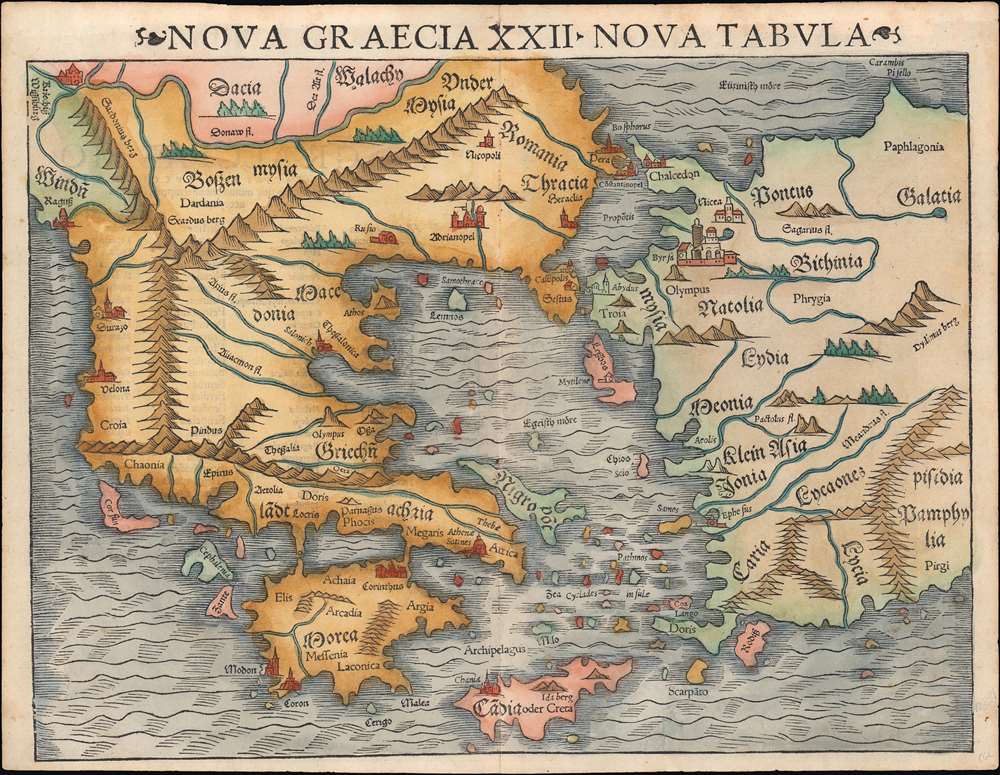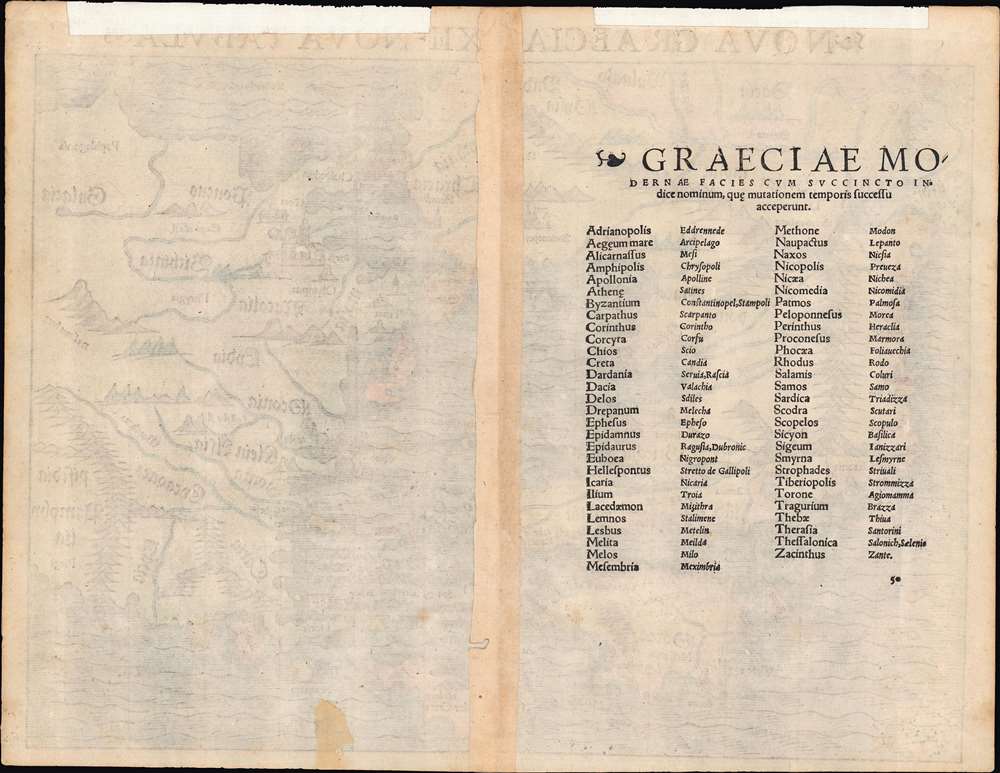This item has been sold, but you can get on the Waitlist to be notified if another example becomes available, or purchase a digital scan.
1545 Munster Modern Map of Greece (2nd issue)
Greece-munster-1545
Title
1545 (undated) 10.25 x 13.5 in (26.035 x 34.29 cm) 1 : 3000000
Description
The Map's Scope and Content
The distinction of this as a modern, not a Ptolemaic map refers not only to the detail within the map but in its overall scope. The maps based on Ptolemy's tenth table of Europe - such as those that appear in the 1477, 1482 and 1513 Ptolemies (as well as Münster's own Tabula Europa X) all share the same focus. They present the Greek peninsula and islands in detail, including Crete, but show almost none of Asia Minor, and detail only as far north as the 'Scardius Mountains' separating Macedonia from Illyricum, or Dalmatia. Although they show the southern part of the Hellespont, Constantinople and the opening of the Black Sea was not included.The first modern regional map to include Greece was the 1513 Waldseemüller Tabula Moderna Bossine, Servia, Gretiae et Sclavoniae which showed Greece along with the Balkans as far north as the Danube, as far south as Crete, and encompassing southern Italy and Sicily in the west, and part of Asia Minor in the east. In contrast, Münster's modern map of Greece specifically focuses on the Greek Peninsula and Islands while including Constantinople and the Bosphorus.
Consequently, this is the first map to focus on Greece, while adding to Ptolemy's toponymy place names useful to the 16th century reader. For example, the ancient Greek Euboea is here replaced with Negropont; Boeotia with Phocis, Corcyra with Corfu.
An Attractive Woodcut
Typical of virtually all maps printed north of the Alps in the first half of the 16th century, this map is a woodcut, lending the work a distinctive aesthetic. Mountain ranges and forests are indicated pictorially, and major cities are likewise presented as small clusters of buildings in profile. Interestingly, the most prominent of these is neither Constantinople, nor any city in Greece proper; the largest shown are Nicea and Bursa, both in Asia Minor. Bursa, in particular, is shown as a great city. Perhaps the scale of the map prevented Münster from showing Constantinople so grandly, but Bursa (spelled Byrsa here) had been the first major capital city of the Ottoman Empire and it remained to be the most important administrative and commercial center in the empire until the 1453 conquest of Constantinople. During Münster's lifetime, Bursa continued to be a wealthy nexus of the Ottoman silk trade, and a major cultural hub.Publication History and Census
Cut by an anonymous formschneider, this map was prepared sometime after 1542 for inclusion in the first edition of Münster's 1544 Cosmographia, and appeared in all editions of that work until 1578. It was included in the 1545 and 1552 editions of Geographia: the present example conforms typographically to the 1545 Geographia edition. This edition of Geographia Universalis is catalogued in thirty-six institutional collections. We see three examples of this edition of the separate map in OCLC, although it appears on the market from time to time.CartographerS
Sebastian Münster (January 20, 1488 - May 26, 1552), was a German cartographer, cosmographer, Hebrew scholar and humanist. He was born at Ingelheim near Mainz, the son of Andreas Munster. He completed his studies at the Eberhard-Karls-Universität Tübingen in 1518, after which he was appointed to the University of Basel in 1527. As Professor of Hebrew, he edited the Hebrew Bible, accompanied by a Latin translation. In 1540 he published a Latin edition of Ptolemy's Geographia, which presented the ancient cartographer's 2nd century geographical data supplemented systematically with maps of the modern world. This was followed by what can be considered his principal work, the Cosmographia. First issued in 1544, this was the earliest German description of the modern world. It would become the go-to book for any literate layperson who wished to know about anywhere that was further than a day's journey from home. In preparation for his work on Cosmographia, Münster reached out to humanists around Europe and especially within the Holy Roman Empire, enlisting colleagues to provide him with up-to-date maps and views of their countries and cities, with the result that the book contains a disproportionate number of maps providing the first modern depictions of the areas they depict. Münster, as a religious man, was not producing a travel guide. Just as his work in ancient languages was intended to provide his students with as direct a connection as possible to scriptural revelation, his object in producing Cosmographia was to provide the reader with a description of all of creation: a further means of gaining revelation. The book, unsurprisingly, proved popular and was reissued in numerous editions and languages including Latin, French, Italian, and Czech. The last German edition was published in 1628, long after Münster's death of the plague in 1552. Cosmographia was one of the most successful and popular books of the 16th century, passing through 24 editions between 1544 and 1628. This success was due in part to its fascinating woodcuts (some by Hans Holbein the Younger, Urs Graf, Hans Rudolph Manuel Deutsch, and David Kandel). Münster's work was highly influential in reviving classical geography in 16th century Europe, and providing the intellectual foundations for the production of later compilations of cartographic work, such as Ortelius' Theatrum Orbis Terrarum Münster's output includes a small format 1536 map of Europe; the 1532 Grynaeus map of the world is also attributed to him. His non-geographical output includes Dictionarium trilingue in Latin, Greek, and Hebrew, and his 1537 Hebrew Gospel of Matthew. Most of Munster's work was published by his stepson, Heinrich Petri (Henricus Petrus), and his son Sebastian Henric Petri. More by this mapmaker...
Heinrich Petri (1508 - 1579) and his son Sebastian Henric Petri (1545 – 1627) were printers based in Basel, Switzerland. Heinrich was the son of the printer Adam Petri and Anna Selber. After Adam died in 1527, Anna married the humanist and geographer Sebastian Münster - one of Adam's collaborators. Sebastian contracted his stepson, Henricus Petri (Petrus), to print editions of his wildly popular Cosmographia. Later Petri, brought his son, Sebastian Henric Petri, into the family business. Their firm was known as the Officina Henricpetrina. In addition to the Cosmographia, they also published a number of other seminal works including the 1566 second edition of Nicolaus Copernicus's De Revolutionibus Orbium Coelestium and Georg Joachim Rheticus's Narratio. Learn More...




